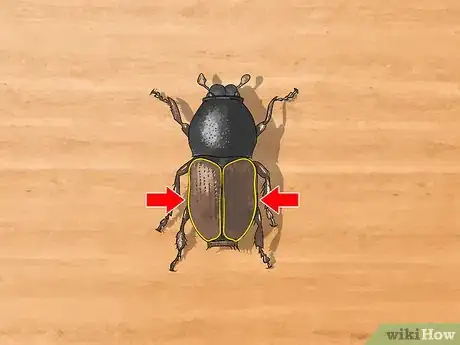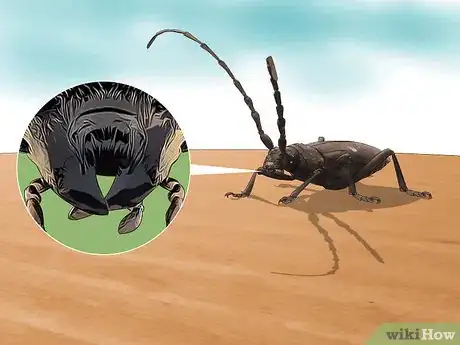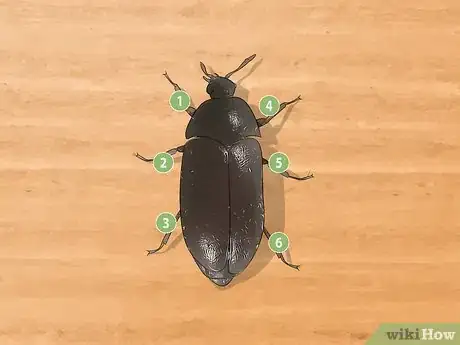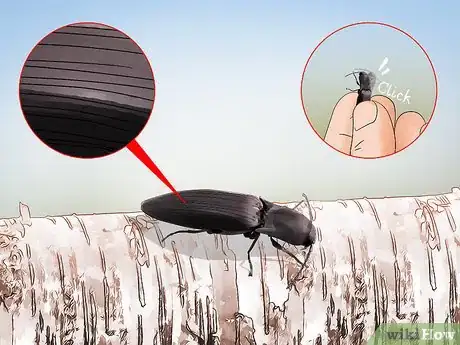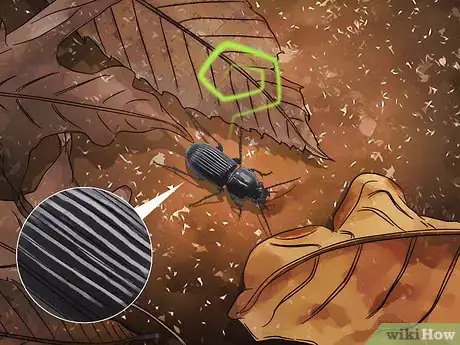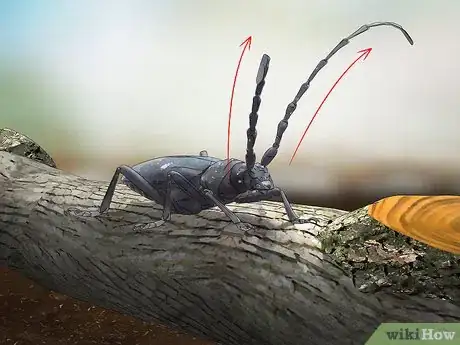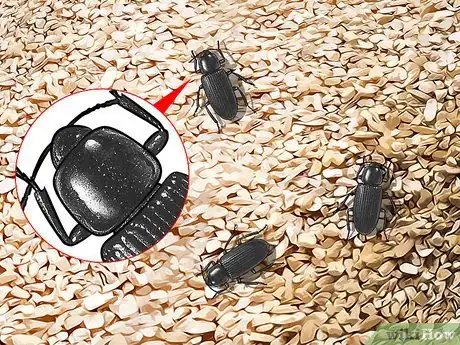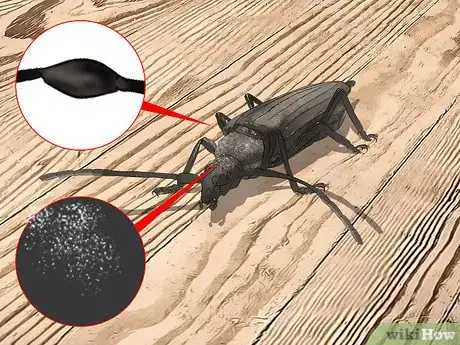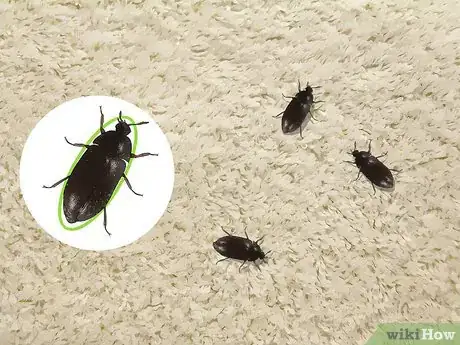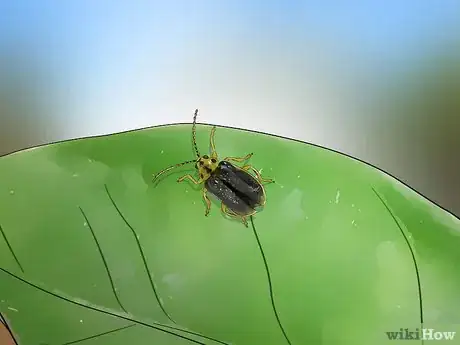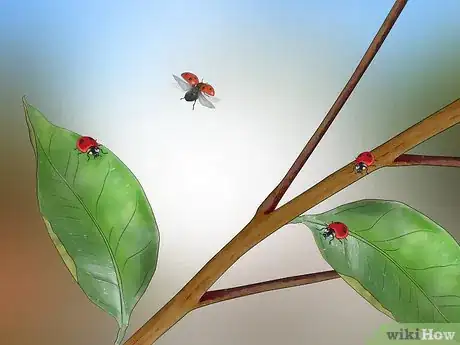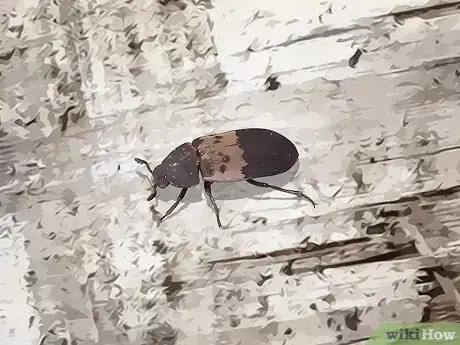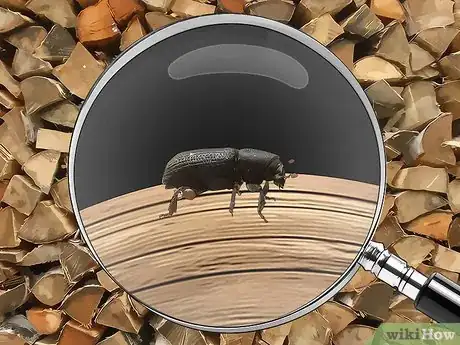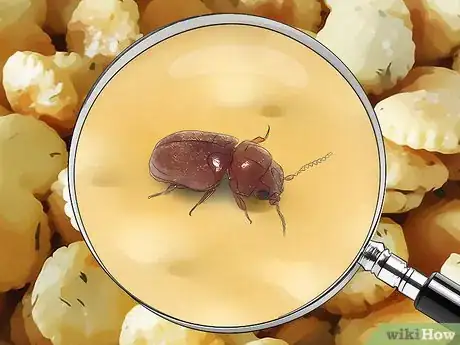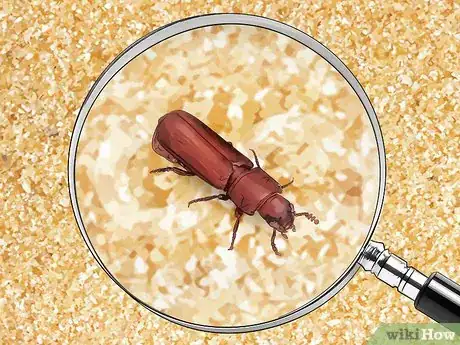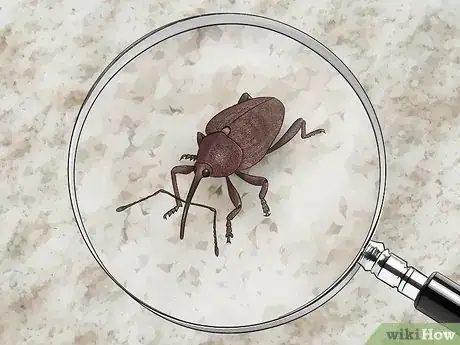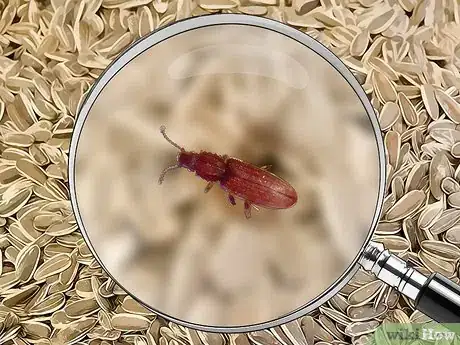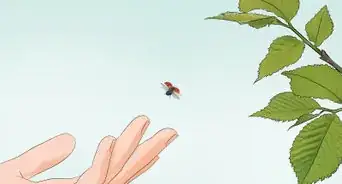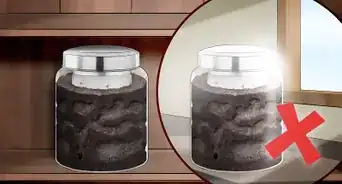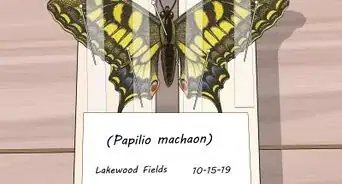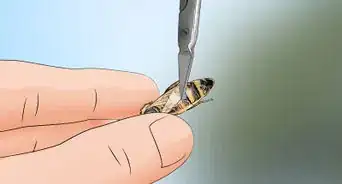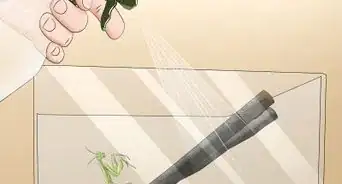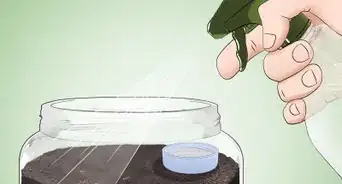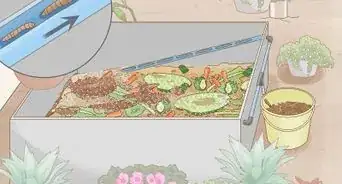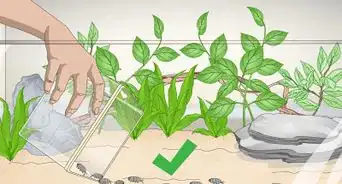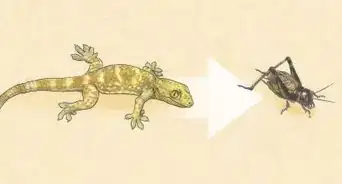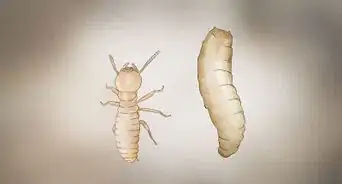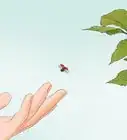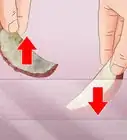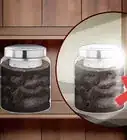This article was co-authored by Shweta Sharma. Shweta Sharma is a Biologist with the U.S. Environmental Protection Agency (EPA). With nearly ten years of experience, she specializes in insect management, integrated pest management, insect behavior, resistance management, ecology, and biological control. She earned her PhD in Urban Entomology and her MS in Environmental Horticulture from the University of Florida. She also holds a BS in Agriculture from the Institute of Agriculture and Animal Sciences, Nepal.
There are 17 references cited in this article, which can be found at the bottom of the page.
This article has been viewed 288,603 times.
There are over 350,000 identified species of beetles![1] This can make it a daunting task to identify a single beetle. However, if you find a beetle in your home or outdoors, you might want to know what kind of beetle you’re looking at. Start by examining the beetle closely to identify its basic features, and then use the beetle's appearance to help you figure what kind of beetle it is.
Steps
Checking for Basic Features of a Beetle
-
1Look for 2 hard wing coverings on the insect’s back. Beetles have wings, but they are covered by 2 hard wing coverings(elytra). This is what gives a beetle its distinctive hard-shelled look. The hardened wing coverings on a beetle’s back are also the reason why a beetle will make a crunching sound if you accidentally step on one.[2]
- If the insect is a beetle, its wings should not be visible unless the coverings are lifted up and the wings are extended.
- Not all beetles have wings that are completely covered.
-
2Check for chewing mouth parts on the underside of its head. Beetles have sharp mandibles (chewing mouthparts) so they can consume other insects, plant matter, fungus, and decaying plants and animals. Look at the underside of the insect’s mouth to see if they have sharp-looking mouthparts.[3]
- If the insect has a long, straw-like protrusion, then it is not a beetle.
Advertisement -
3See if the insect has 6 legs. Beetles have 6 legs distributed between their front and back body segments. When they are in their larval stage, the legs are all on the front of a beetle’s body. Otherwise, the legs are spread between the front and back segments. Count the insect’s legs and check their location to determine if it is a beetle.[4]
- If the insect has 4 legs, 8 legs, or more, then it is not a beetle.
Identifying Large Beetles
-
1Identify a click beetle by a narrow, long body and a clicking sound. Click beetles, also known as Elateridae, can snap the front and back sections of its body together to make a clicking sound, and it can also use this motion to flip itself over if it gets stuck on its back. Click beetles are black or dark brown, and they have grooved sections running down their backs.[5]
- An adult click beetle may be between 0.5 to 1.5 in (1.3 to 3.8 cm) long.
- This beetle is common all over the world and there are over 900 species of click beetles in North America alone.
-
2Watch for a fast moving beetle with a strong smell to spot a ground beetle. Ground beetles are black with grooves on their backs, and they produce a strong odor. They usually hang out under logs and leaves, but they may wander into your house through a crack or open window. These beetles move quickly, so it might be hard to get a close look.[6]
- Keep in mind that these beetle are harmless. They eat other insects, but will not bite you or your pets.
-
3Check for longhorn beetles with long-antennae hanging out around dead trees. These are called longhorn beetles because their antennae are reminiscent of longhorn cattle. The antennae may be straight, curved, or half and half. Longhorn beetle coloring can range from black, brown, green, yellow, red, or a combination of these colors.[7]
- There are 413 species of longhorn beetles in Texas alone, but they all share the distinguishing feature of long antennae.
-
4Inspect the head of the beetle for a scoop shape to see if it’s a mealworm. If the beetle has a rounded head with a scoop neck shape around the base of it, then it is most likely a mealworm. Despite the name, these are actually beetles. Mealworms usually live outdoors, but you may find them infesting containers of flour and other dried grains.[8]
- Keep your grains in air-tight containers to prevent an infestation.[9]
-
5Identify an oldhouse borer by white spots on its wings and enlarged leg segments.[10] If you look closely at an oldhouse borer, you may notice small gray hairs on its back. You may also be able to make out 3 dark eyes on each side of the beetle’s mouth.[11]
- These beetles usually turn up in a house about 4 to 7 years after it has been built.
Identifying Small Beetles
-
1Check for a black body with an elongated abdomen to identify a carpet beetle. This is most likely a black carpet beetle.[12] These beetles are usually black or very dark brown and their bodies are oval shaped. They range in size from 0.12 to 0.19 inches (0.30 to 0.48 cm).[13]
- Varied color carpet beetles are similar to black carpet beetles. These are very small (0.12 in (0.30 cm)) beetles with bright yellow and green markings.[14]
-
2Look for green and black stripes on an elm beetle. These beetles are 0.25 in (0.64 cm) long.[15] They feed on tree leaves, especially on elm tree leaves, and they lay their eggs on the undersides of leaves as well.[16]
- Elm leaf beetles can damage trees if they get out of control, so you may need to manage them with pesticides.
-
3Identify ladybugs by a brightly-colored, rounded body and black spots. These are also known as lady beetles and in some countries, ladybirds.[17] Their bodies may be yellow, orange, or red with black markings, but they can also be black with red, orange, or yellow markings.[18]
- There are over 450 species of lady beetles in North America alone.
-
4Protect your ham from larger beetles. Larder beetles are black beetles that are known to infest cured ham. They have a whitish, silver streak running across their back and they are oval-shaped.[19]
- Be sure to keep ham covered when it is out, and put it in the refrigerator to store it.
-
5Watch for cylindrical-shaped bark beetles around firewood. Bark beetles are only about 0.12 in (0.30 cm) and they are common around piles of firewood.[20] Bark beetles may also infest live trees, which may die as a result of a bark beetle infestation.[21]
- Bark beetle infestations create dry, dead wood, which intensifies forest fires.
-
6Identify drug store beetles by lines on the wing covers and a slightly bent head. The coloring of these beetles may range from brown to reddish brown, and they are around 0.1 to 0.14 in (0.25 to 0.36 cm) long. These beetles infest packaged food.[22]
- If the head is so far bent over that the beetle has a hump, then it is likely a cigarette beetle. These are almost identical to drugstore beetles but they appear to be hunchbacked.[23]
-
7Check for rust beetles with a rust-colored, flattened body with clubbed antennae. These are also known confused flour beetles.[24] These beetles feed on corn flour and other packaged products.[25]
- Make sure to keep your corn flour and other flours in air-tight containers to protect them from these pests.
-
8Inspect your rice and grains for long-beaked beetles called weevils. Weevils are only about 0.12 in (0.30 cm) and brown with a pointed head that resembles a beak. Their bodies are long and slender.[26]
- Weevil infestations in rice and other grains are common. These pests can chew right through paper and plastic, so it is best to keep any loose grains and flour in air-tight glass, metal, or hard plastic containers.[27]
-
9Look for protrusions on the sides of a saw-toothed beetle’s thorax. These beetles are only about 0.12 in (0.30 cm) long. Their favorite foods to infest and eat are sunflower seeds and nuts, but they can also infest large quantities of grains.[28]
- Sawtoothed grain beetles are more likely to get into the food supply if the bins are not sanitized at least every 6 months.[29]
Community Q&A
-
QuestionWhat is a large, hard-shell, flying beetle that looks much like a stinkbug?
 Community AnswerIt most likely is a cockchafer. These beetles are vegetarians and do humans no harm.
Community AnswerIt most likely is a cockchafer. These beetles are vegetarians and do humans no harm. -
QuestionDo you know the identity of a small beetle with a narrow, orange "V" on its back?
 Community AnswerIt is maybe a stink bug or an assassin bug. They look like beetles, but they are not.
Community AnswerIt is maybe a stink bug or an assassin bug. They look like beetles, but they are not. -
QuestionWill beetles attack you?
 Community AnswerGenerally not. Most beetle species cannot bite, but some species that live off plants or carcasses have powerful jaws that can bite you. Some species have males with enormous mouthparts that are used in battle. These mouthparts or antlers can also be used against humans and this will hurt, but cannot seriously harm you.
Community AnswerGenerally not. Most beetle species cannot bite, but some species that live off plants or carcasses have powerful jaws that can bite you. Some species have males with enormous mouthparts that are used in battle. These mouthparts or antlers can also be used against humans and this will hurt, but cannot seriously harm you.
References
- ↑ https://evolution.berkeley.edu/evolibrary/article/side_O_0/beetles_01
- ↑ http://www.coleoptera.org.uk/what-are-beetles
- ↑ https://citybugs.tamu.edu/factsheets/household/beetles-house/what-are-beetles/
- ↑ https://citybugs.tamu.edu/factsheets/household/beetles-house/what-are-beetles/
- ↑ http://www.biokids.umich.edu/critters/Elateridae/
- ↑ https://hortnews.extension.iastate.edu/ground-beetle
- ↑ http://texasento.net/TXBycidPix.html
- ↑ https://www.insectid.ento.vt.edu/insect-id/identify-pests/adult/beetles/large-beetle/index.html
- ↑ https://go.walsall.gov.uk/mealworm_beetles
- ↑ https://www.insectid.ento.vt.edu/insect-id/identify-pests/adult/beetles/large-beetle/index.html
- ↑ https://extension.psu.edu/old-house-borer
- ↑ https://www.insectid.ento.vt.edu/insect-id/identify-pests/adult/beetles/small-beetle/index.html
- ↑ http://entnemdept.ufl.edu/creatures/fabric/black_carpet_beetle.htm
- ↑ https://www.insectid.ento.vt.edu/insect-id/identify-pests/adult/beetles/small-beetle/index.html
- ↑ https://www.insectid.ento.vt.edu/insect-id/identify-pests/adult/beetles/small-beetle/index.html
- ↑ http://entnemdept.ufl.edu/creatures/fabric/black_carpet_beetle.htm
- ↑ https://www.insectid.ento.vt.edu/insect-id/identify-pests/adult/beetles/small-beetle/index.html
- ↑ https://biocontrol.entomology.cornell.edu/predators/ladybeetles.php
- ↑ https://www.insectid.ento.vt.edu/insect-id/identify-pests/adult/beetles/small-beetle/index.html
- ↑ https://www.insectid.ento.vt.edu/insect-id/identify-pests/adult/beetles/small-beetle/brown-beetle/index.html
- ↑ https://www.fs.usda.gov/Internet/FSE_DOCUMENTS/stelprdb5384837.pdf
- ↑ https://www.insectid.ento.vt.edu/insect-id/identify-pests/adult/beetles/small-beetle/brown-beetle/index.html
- ↑ https://www.insectid.ento.vt.edu/insect-id/identify-pests/adult/beetles/small-beetle/brown-beetle/index.html
- ↑ https://www.insectid.ento.vt.edu/insect-id/identify-pests/adult/beetles/small-beetle/brown-beetle/index.html
- ↑ https://keys.lucidcentral.org/keys/v3/eafrinet/maize_pests/key/maize_pests/Media/Html/Tribolium_castaneum_(Herbst_1797)_-_Red_Flour_Beetle.htm
- ↑ https://www.insectid.ento.vt.edu/insect-id/identify-pests/adult/beetles/small-beetle/brown-beetle/index.html
- ↑ https://www.thekitchn.com/how-to-prevent-get-rid-of-grai-140955
- ↑ https://www.insectid.ento.vt.edu/insect-id/identify-pests/adult/beetles/small-beetle/brown-beetle/index.html
- ↑ https://ento.psu.edu/extension/factsheets/sawtoothed-and-merchant-grain-beetle
About This Article
To identify a beetle, start by estimating its size and noting the color of its body. Then, examine the beetle's body to see if it's round, boxy, oval, tapered, or a different shape. Next, check the beetle for any long or unusually shaped legs and antennae, which could help you deduce what kind of beetle it is. Finally, look at the beetle's body to see if it has any texture or protrusions, like horns on its head. Once you've noted all of these characteristics, use them to research and narrow down what kind of beetle you're looking at. To learn how to identify large, small, or colorful beetles, keep reading!
